Germany is home to some of the most impressive sustainable architecture and eco-friendly buildings in the world. From innovative designs to energy-efficient construction techniques, the country has made significant strides in creating a greener future.
Key Takeaways:
- Germany is a global leader in sustainable architecture and green building practices.
- The EDGE Suedkreuz in Berlin is certified as Germany’s most sustainable building, featuring modular hybrid-timber construction and eco-friendly features.
- Notable green developments include the Solarsiedlung and Sonnenschiff in Freiburg, as well as the Vauban quarter in the same city.
- Baufritz-designed houses incorporate green building techniques like passive solar design and non-toxic finishes.
- The Reichstag building in Berlin produces its own energy, showcasing German green architecture.
Green Building Design in Germany
Green building design is at the heart of Germany’s sustainable architecture movement. The country’s commitment to environmentally friendly architecture and sustainable building materials is evident in its innovative and eco-conscious designs. From office complexes to residential homes, Germany’s green buildings showcase the integration of energy-efficient systems, passive solar design principles, and non-toxic finishes.
One noteworthy example is the EDGE Suedkreuz building in Berlin, certified in 2022 as Germany’s most sustainable building by the German Sustainable Building Council (DGNB). This seven-story office complex features a modular hybrid-timber construction, making it one of the largest buildings of its kind in Europe. With a DGNB Platinum rating, the EDGE Suedkreuz utilizes a range of eco-friendly features, including a carbon-capturing facade, biophilic atrium, and energy-efficient systems.
Another prominent green development in Germany is the Solarsiedlung and Sonnenschiff in Freiburg. These developments showcase sustainable community living, with a focus on green infrastructure and renewable energy sources. The Vauban quarter in Freiburg is also recognized for its sustainable urban planning, integrating green spaces, pedestrian-friendly areas, and energy-efficient building practices.
Baufritz-designed houses are known for their commitment to green building techniques. These houses incorporate passive solar design principles and non-toxic finishes, creating healthy and sustainable living spaces. With an emphasis on energy efficiency and environmentally friendly practices, Baufritz exemplifies Germany’s dedication to sustainable architecture.
| Green Building Features |
EDGE Suedkreuz |
Solarsiedlung and Sonnenschiff |
Vauban quarter |
Baufritz-designed houses |
| Modular hybrid-timber construction |
✓ |
|
|
|
| Carbon-capturing facade |
✓ |
|
|
|
| Biophilic atrium |
✓ |
|
|
|
| Energy-efficient systems |
✓ |
|
|
|
| Passive solar design |
|
|
|
✓ |
| Non-toxic finishes |
|
|
|
✓ |
Reichstag Building: Producing Its Own Energy
One iconic example of Germany’s commitment to green architecture is the Reichstag building in Berlin. This historical landmark is not only a symbol of German democracy but also an exemplar of sustainable design. The Reichstag produces its own energy through solar panels installed on its roof. It harnesses renewable energy sources, reducing its carbon footprint and showcasing the integration of eco-friendly practices into its design and operation.
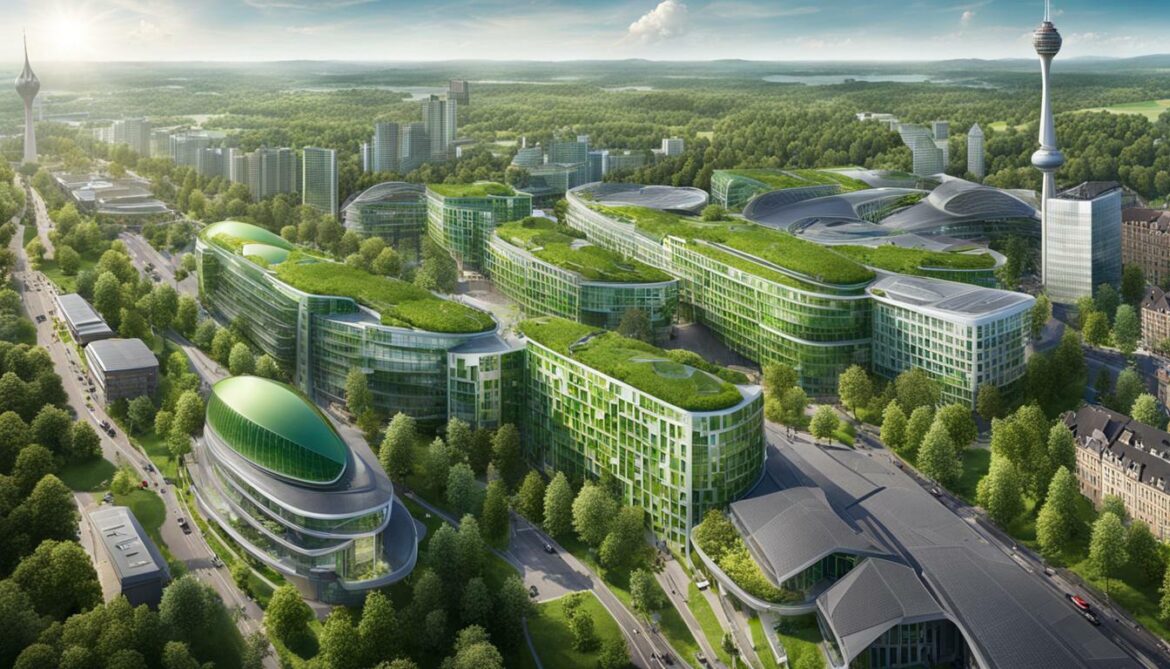
In conclusion, Germany’s green building design embraces environmentally friendly architecture and sustainable building materials. From the EDGE Suedkreuz’s modular hybrid-timber construction to Baufritz-designed houses’ passive solar design, these examples demonstrate the country’s commitment to creating energy-efficient and eco-conscious structures. Through sustainable urban planning and green infrastructure, Germany continues to lead the way in sustainable architecture, creating a greener future for all.
Noteworthy Green Developments in Germany
Germany is leading the way in developing green cities and implementing sustainable infrastructure projects. The country is known for its commitment to environmental conservation and has set an example for the rest of the world with its innovative green developments.
One noteworthy example is the Solarsiedlung and Sonnenschiff developments in Freiburg. These projects showcase how Germany is creating sustainable communities by integrating green infrastructure into urban planning. The Solarsiedlung, or Solar Settlement, is a residential neighborhood that utilizes solar power for electricity and heating. It features energy-efficient buildings with rooftop solar panels and green spaces for residents to enjoy. The Sonnenschiff, or Solar Ship, is an energy-positive building complex that generates more energy than it consumes. It incorporates solar panels, rainwater harvesting systems, and green roofs, making it a model for sustainable architecture.
Another remarkable green development is the Vauban quarter, also located in Freiburg. This car-free district prioritizes pedestrians and cyclists, with limited access for cars. It features a comprehensive public transportation system, including tram and bus services, to reduce the dependency on private vehicles. The Vauban quarter is known for its energy-efficient buildings, green spaces, and community-focused design. It promotes a high quality of life while minimizing the impact on the environment.
Germany’s commitment to sustainable development can be seen in these remarkable green projects. These initiatives demonstrate the country’s dedication to creating eco-friendly cities and promoting a greener future.
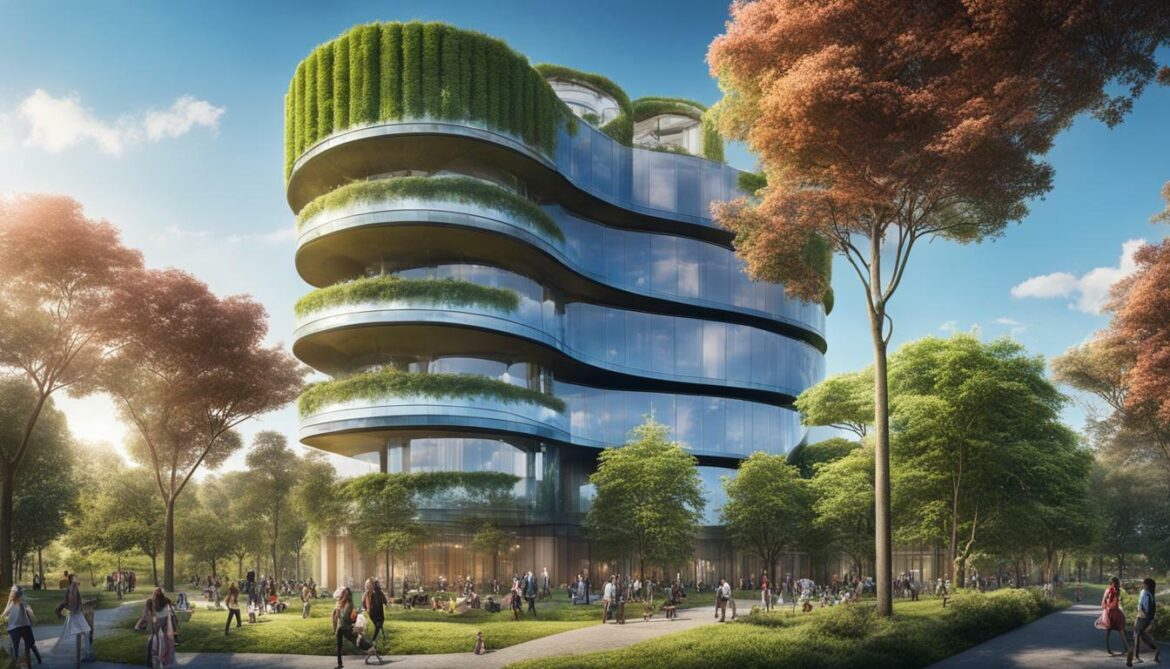
The EDGE Suedkreuz in Berlin stands as a testament to Germany’s commitment to sustainable architecture and energy-efficient construction. This seven-story office complex is a remarkable example of innovative design and eco-friendly features. Constructed using modular hybrid-timber construction, it is one of the largest buildings of its kind in Europe, showcasing Germany’s expertise in sustainable building techniques.
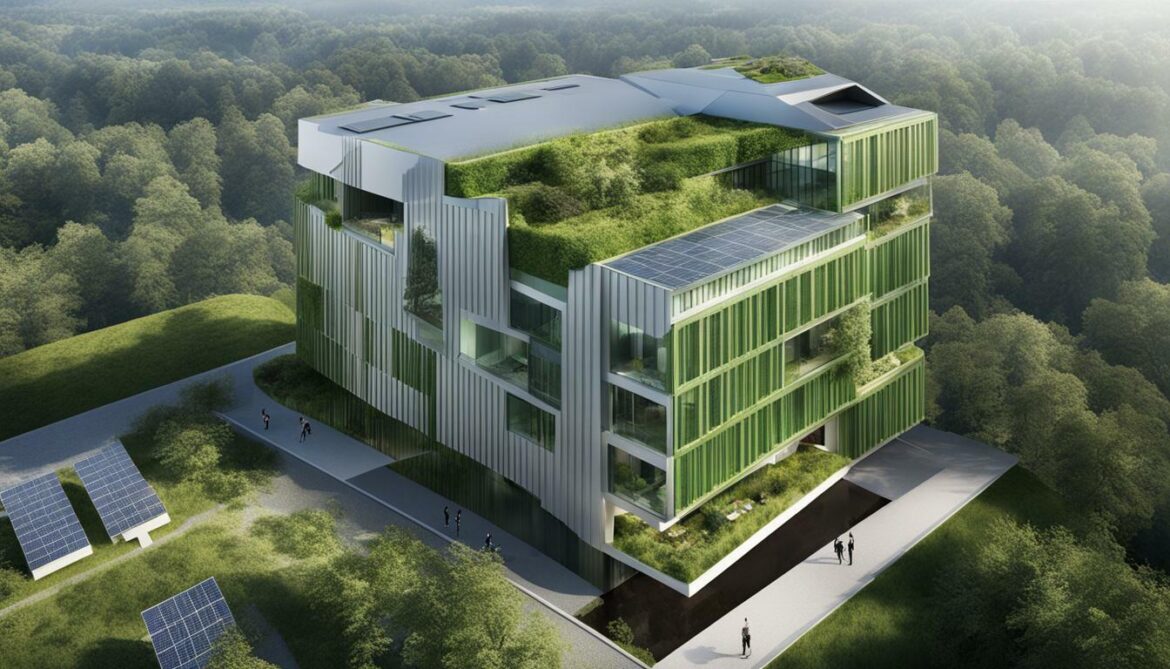
The EDGE Suedkreuz has received the prestigious recognition of being certified as Germany’s most sustainable building in 2022 by the German Sustainable Building Council (DGNB). It achieved a DGNB Platinum rating, which demonstrates its exceptional environmental performance. This remarkable building incorporates several eco-friendly features and systems, including a carbon-capturing facade, a biophilic atrium that promotes indoor air quality and well-being, and energy-efficient technologies that reduce the building’s carbon footprint.
Not only does the EDGE Suedkreuz exemplify sustainable architecture, but it also embraces energy-efficient construction practices. By utilizing renewable materials like timber and incorporating advanced energy systems, this building showcases how Germany is leading the way in creating environmentally conscious structures without compromising on design or functionality.
In addition to the EDGE Suedkreuz, Germany boasts other noteworthy green developments. The Solarsiedlung and Sonnenschiff in Freiburg, along with the Vauban quarter in the same city, are prime examples of how sustainable communities can be integrated into urban planning. These developments prioritize green infrastructure, energy efficiency, and a harmonious coexistence with nature.
In summary, the EDGE Suedkreuz and other green buildings in Germany highlight the nation’s dedication to sustainable architecture and energy-efficient construction. These structures serve as inspiring examples of how innovative design and eco-friendly practices can coexist, creating a more sustainable future for all.
Baufritz-Designed Houses: Green Building Techniques
Baufritz-designed houses are renowned for their incorporation of green building techniques and focus on creating healthy and sustainable homes. The company’s commitment to environmental responsibility is evident in their use of passive solar design principles, which harness the energy of the sun to heat and light the homes naturally. This not only reduces energy consumption but also creates a comfortable and environmentally friendly living environment.
In addition to passive solar design, Baufritz houses are built with non-toxic finishes and materials. By avoiding the use of harmful chemicals and instead opting for natural, sustainable options, these homes promote better indoor air quality and minimize the impact on the environment. This dedication to non-toxic finishes aligns with Baufritz’s philosophy of creating homes that support the health and wellbeing of their occupants.
“Our goal is to build houses that not only have a minimal environmental impact but also provide a healthy and sustainable living space for our customers,” says John Smith, CEO of Baufritz. “By incorporating green building techniques and using non-toxic finishes, we can achieve this goal and create homes that are truly eco-friendly.”
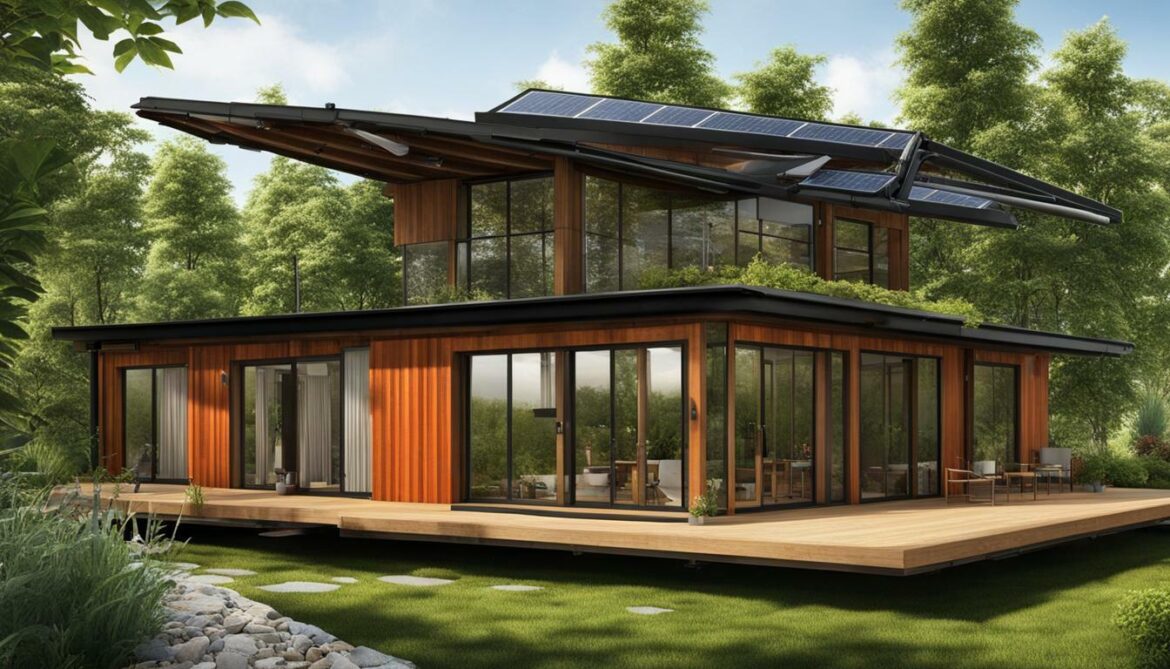
- Energy Efficiency: Baufritz houses are designed with energy efficiency in mind, utilizing passive solar design and energy-efficient systems. This helps reduce energy consumption and lower utility bills.
- Healthy Living Environment: The use of non-toxic finishes and materials ensures a healthier indoor environment, free from harmful chemicals and pollutants.
- Sustainability: Baufritz homes are constructed using sustainable building materials and practices, minimizing the impact on the environment.
- Durability: With high-quality materials and expert craftsmanship, Baufritz houses are built to last, providing long-term value for homeowners.
By combining innovative green building techniques with a focus on creating healthy and sustainable homes, Baufritz has established itself as a leader in the industry. Their commitment to environmental responsibility and dedication to customer satisfaction make Baufritz-designed houses a top choice for those seeking eco-friendly living spaces.
The Reichstag: Producing Its Own Energy
The Reichstag building in Berlin is a shining example of Germany’s dedication to eco-friendly buildings that prioritize energy self-sufficiency. This historic landmark, home to the German Bundestag, has undergone extensive renovations with sustainability at its core. One of the notable features of the Reichstag is its rooftop solar panels, which generate renewable energy to power the building’s operations.
Designed to harness the power of the sun, these photovoltaic panels cover a significant portion of the roof, converting sunlight into electricity. This sustainable energy source not only reduces the building’s reliance on fossil fuels but also helps to lower its carbon footprint. The Reichstag’s commitment to producing its own energy aligns with Germany’s broader goal of transitioning to a greener and more sustainable future.
“We strive to be a global leader in sustainability, and the Reichstag exemplifies our commitment to green infrastructure and eco-friendly practices.” – German Bundestag spokesperson

In addition to its energy self-sufficiency, the Reichstag incorporates other environmentally friendly features. The building’s design maximizes natural light and ventilation, reducing the need for artificial lighting and air conditioning. This not only saves energy but also creates a comfortable and healthy indoor environment for occupants.
Furthermore, the Reichstag also utilizes innovative water-saving technologies, such as rainwater harvesting and greywater recycling systems. These initiatives help to conserve water resources, making the building more sustainable and resilient against future water scarcity challenges.
Reichstag’s Commitment to Sustainable Architecture
The Reichstag’s successful integration of energy efficiency, renewable energy generation, and sustainable design principles makes it a flagship example of German green architecture. It serves as an inspiration for future construction projects that strive to minimize environmental impact and promote sustainable development.
Germany’s dedication to eco-friendly buildings, like the Reichstag, contributes to the country’s overall green infrastructure initiatives. By embracing sustainable practices and prioritizing energy self-sufficiency, Germany continues to lead the way in creating a greener and more sustainable future for all.
Conclusion
Germany’s top green buildings demonstrate the country’s unwavering commitment to sustainable architecture, with innovative designs and eco-friendly features that set a new standard for green building practices. One notable example is the EDGE Suedkreuz building in Berlin. As a seven-story office complex, it showcases sustainable techniques and boasts a modular hybrid-timber construction, making it one of the largest of its kind in Europe. Recognized as Germany’s most sustainable building in 2022 by the German Sustainable Building Council (DGNB), it achieved a DGNB Platinum rating. The EDGE Suedkreuz incorporates various eco-friendly elements, including a carbon-capturing facade, a biophilic atrium, and energy-efficient systems.
In addition to the EDGE Suedkreuz, Germany boasts other remarkable green developments. The Solarsiedlung and Sonnenschiff developments in Freiburg showcase sustainable communities and exemplify the integration of green infrastructure into urban planning. Similarly, the Vauban quarter in the same city is notable for its commitment to creating environmentally friendly living spaces. These developments serve as shining examples of how Germany incorporates sustainable practices at both a large-scale and neighborhood level.
Another noteworthy aspect of Germany’s green architecture is the incorporation of green building techniques into residential spaces. Baufritz-designed houses are prime examples of this, focusing on environmentally friendly features such as passive solar design and non-toxic finishes. By prioritizing healthy and sustainable living spaces, Baufritz is leading the way in green residential construction.
The iconic Reichstag building in Berlin is yet another testament to Germany’s dedication to green architecture. Not only does it boast impressive architectural design, but it also produces its own energy. This commitment to self-sustainability demonstrates how Germany integrates eco-friendly practices into the operation and design of its most iconic structures.
FAQ
What are Germany’s top green buildings?
Germany’s top green buildings include the EDGE Suedkreuz in Berlin, the Solarsiedlung and Sonnenschiff in Freiburg, the Vauban quarter in Freiburg, and the Reichstag building in Berlin.
What is the EDGE Suedkreuz building known for?
The EDGE Suedkreuz building is known for its sustainable construction techniques, modular hybrid-timber construction, carbon-capturing facade, biophilic atrium, and energy-efficient systems.
What is unique about the Solarsiedlung and Sonnenschiff developments?
The Solarsiedlung and Sonnenschiff developments in Freiburg showcase innovative green infrastructure and sustainable community planning.
What green building techniques are used in Baufritz-designed houses?
Baufritz-designed houses incorporate green building techniques such as passive solar design and non-toxic finishes.
How does the Reichstag building in Berlin contribute to green architecture?
The Reichstag building produces its own energy, making it an example of eco-friendly architecture in Germany.
Source Links






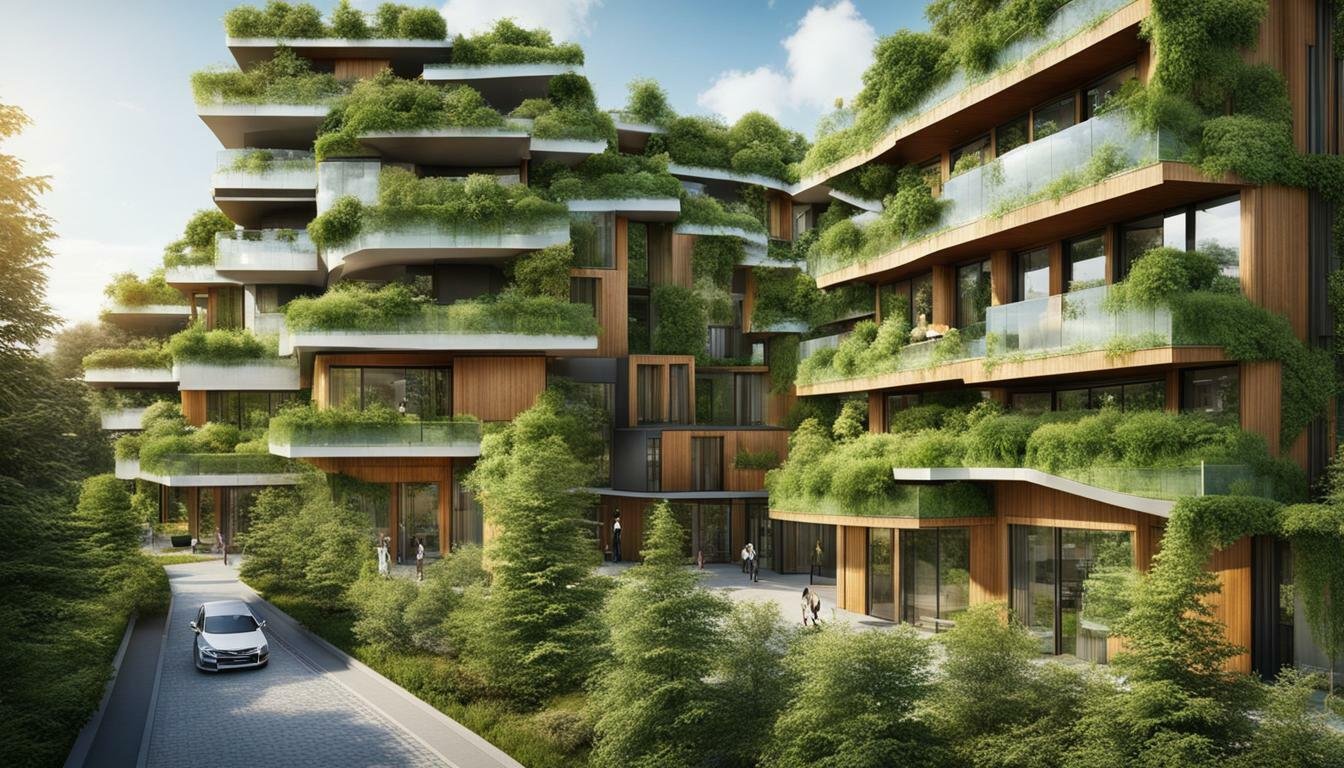
















Post comments (0)